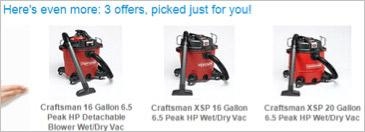Commentary
How To Avoid Email Automation Embarrassment
- by Amanda Hinkle , September 27, 2013
The first and “hero” layer included offers picked “just for him:"

Why would someone who just purchased a Wet/Dry Vac need another one? How about three additional Wet/Dry Vacs? This is a case of automated product recommendations gone awry, ending up in a humorous display of Wet/Dry Vacs layered across the screen.
The next row of recommended items was suggested because of his most recent purchase. These recommendations are reasonable – they complement the Wet/Dry Vac and could conceivably be add-ons someone might consider a week after having the item in their possession.
advertisement
advertisement

The final three additional rows of product recommendations that were included in the email – which consisted of “Picks to pair with what you recently bought,” “Finds by other customers in the same market” and “Hits among shoppers like you” – were repetitive, did little to add value and made the email scroll too long.
Sometimes in your attempt to drive more revenue from the email channel, efforts can get out of hand. Let this be an example of mistakes to be sure to avoid when incorporating automated product recommendations into your email marketing campaigns.
So what specific actions can you take to avoid automation embarrassment? The following are a few suggestions:
Tip 1: Create different experiences based on what you know about your consumer. You can start by segmenting your audience based on whether they are a new customer or a customer who has purchased previously. If you have both brick-and-mortar and ecommerce stores, also look at whether someone purchased in-store or online.
In this case, my colleague purchased his Wet/Dry Vac at his local store and subsequently signed up for its loyalty program. It’s likely all three “hero” recommendations ended up as Wet/Dry Vacs because the retailer did not have any other past purchase data to go on. For new email subscribers/customers, consider how the experience should be modified. In this case, when recommendations were automatically generated from a single past purchase, the system generated a repetitive display that recommended the same product over and over. Make sure you understand all the scenarios that can drive recommendations and have processes in place to display relevant information.
Tip 2: Organize messages in a consumer-friendly format. Not only were the recommendations in the email pictured above repetitive, the message was also too long. How can a consumer differentiate between the many sections: "picked just for you," "suggested by your last purchase," "picks to pair with your recent purchase," "finds by other customers in the same market," and "hits among shoppers like you"? Likely, he doesn’t. The consumer is not going to think in those terms. This schema is organization-centric, as the algorithm driving the recommendations are likely different for each section. It’s nice to provide options, but be sure to stay away from organizing consumer emails based on technology functionality. Rather, test to find the consumer preference sweet spot in terms of number and type of recommendations. Keep it consumer-friendly!
Tip 3: Put yourself in the consumer's shoes -- go through the experience to see what it’s like. Automation/product recommendation engines can significantly decrease the level of effort required to produce compelling messaging. With that said, someone should periodically be “checking your work” to ensure a good customer experience. It should be easy to make purchases under different profiles to see what the customer experience is like, and doing so will help uncover opportunities to fine-tune your efforts.
Sending out emails that recommend related products or services based on the most recent or historical purchase (or search) behavior demonstrate that you really know your customer. Automation and recommendation engines can serve up an even more relevant experience across the customer lifecycle at a fraction of the cost. A sophisticated automated program can create brand awareness, prompt (repeat) purchases and create stickiness with your customer, driving significant ROI. Just be sure to develop customer-centric programs and double check your work to ensure the message your brand delivers is being presented in a favorable way.



Very good article. I agree with almost everything. I'd just like to point out that nobody gets this sort of targeting completely right - for example even Facebook and Amazon sometimes show me totally inappropriate adverts or suggestions - and it's worse if you use a solution that's not real-time. But this shouldn't stop you suggesting products in your emails or on your site because the technology is cheap and the ROI good.
Thanks Pete. You're right -- no one gets this type of targeting completely right... which sometimes turns into a bit of levity sprinkled on top of inspiration.